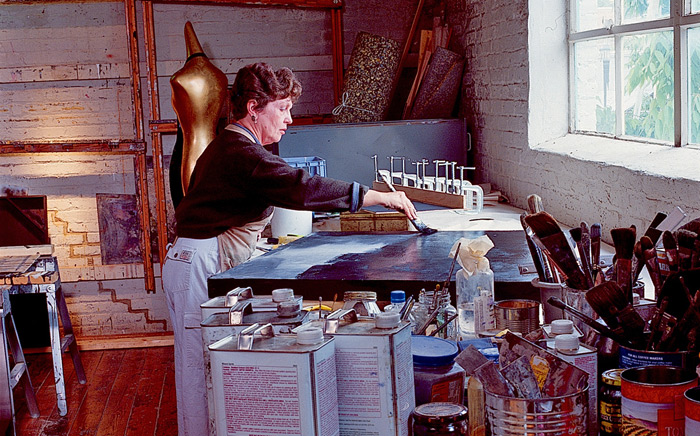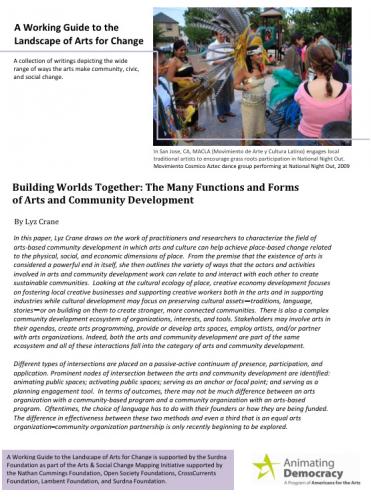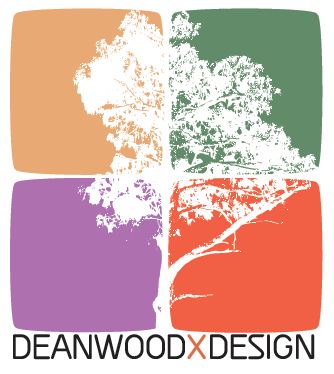
ArtSpace is a national organization, headquartered in Minneapolis, which works to transform communities through the arts. The organization runs 33 affordable, artist-housing facilities throughout the country, in both urban and rural areas, that help improve the livability of their neighborhoods by repurposing old or abandoned buildings to attract artists to live and work in the community.
Read more »
Lyz Crane draws on the work of practitioners and researchers to characterize the field of arts-based community development in which arts and culture can help achieve place based change related to the physical, social, and economic dimensions of place. This paper examines the premise that the existence of arts is considered a powerful end in itself, Crane then outlines the variety of ways that the actors and activities involved in arts and community development work can relate to and interact with each other to create sustainable communities. Looking at the cultural ecology of place, creative economy development focuses on fostering local creative businesses and supporting creative workers both in the arts and in supporting industries while cultural development may focus on preserving cultural assets—traditions, language, stories—or on building on them to create stronger, more connected communities. There is also a complex community development ecosystem of organizations, interests, and tools. Stakeholders may involve arts in their agendas, create arts programming, provide or develop arts spaces, employ artists, and/or partner with arts organizations. Indeed, both the arts and community development are part of the same ecosystem and all of these  interactions fall into the category of arts and community development. interactions fall into the category of arts and community development.
Crane places different types of intersections on a passive-active continuum of presence, participation, and application. Prominent nodes of intersection between the arts and community development are identified: animating public spaces; activating public spaces; serving as an anchor or focal point; and serving as a planning engagement tool. Crane points out that, in terms of outcomes, there may not be much difference between an arts organization with a community-based program and a community organization with an arts-based program. Oftentimes, the choice of language has to do with their founders or how they are being funded. The difference in effectiveness between these two methods and even a third that is an equal arts organization–community organization partnership is only recently beginning to be explored.
Click here to download the whole document.
Read more »
Terms:2012, Arts & Culture, Business, CBC Report/Publication, Community Building, Community Development, Community Engagement, Creative Economy, Cultural Institutions, Featured, Other Reports/Publications, Placemaking, Public Art, Public-Private Partnerships

By Diana Nash of the Pink Line Project on July 12, 2012
There is a buzzword circulating in the DC arts scene that I had not heard about until I returned to the city two months ago. While the concept of using the arts to spur economic and community development is not new, DC is getting attention for the success of its “Arts and Culture Temporiums” since the first one launched along the H Street NE corridor in 2010. Temporiums fall under the larger category of the Temporary Urbanism Initiative, a project undertaken by the DC Office of Planning. The goal behind the initiative, and more specifically, temporiums, is to activate vacant or underutilized spaces by using them to showcase the talent of local artists and other creative entrepreneurs, along with the retail potential that lies within emerging neighborhoods. Think of them as “Pop Ups” that stay around a little longer and have greater potential benefits for the communities where they take place. Jessica Scheuerman, of Partners for Livable Communities, explains that temporiums allow people to “take risks, explore partnerships, and to commit to something” without the burden of a long-term commitment. Temporiums connect creative people seeking affordable space in their neighborhoods with landlords who have the available space that they haven’t been able to lease. It is a smart and increasingly popular concept that lays the groundwork for longer-term collaboration between property owners and neighborhood entrepreneurs.
Building on the success of earlier temporiums, the Office of Planning is targeting four emerging creative neighborhoods to benefit from a $250,000 grant to the city from ArtPlace, an unprecedented new private-public organization. ArtPlace is part of a national “creative place-making” movement that aims to drive revitalization across the country with arts at the center of economic development. The launch of DeanwoodxDesign marks the next step in the OP/ArtPlace grant initiative.
Read more »
Terms:2012, Announcements, Arts & Culture, CBC Press/Media, Community Building, Creative Economy, Culture Builds Communities, Neighborhood Revitalization, Other Events, Public Art, Washington, DC
 The D.C. Office of Planning (OP) has awarded a $75,000 “ArtPlace Arts and Culture Temporium” grant to Partners for Livable Communities (Partners) to develop and manage temporiums in underutilized spaces in the Deanwood neighborhood, one of the District’s earliest African American communities. The D.C. Office of Planning (OP) has awarded a $75,000 “ArtPlace Arts and Culture Temporium” grant to Partners for Livable Communities (Partners) to develop and manage temporiums in underutilized spaces in the Deanwood neighborhood, one of the District’s earliest African American communities.
Under this grant, Partners will develop and manage DeanwoodxDesign, a project that showcases the rich arts, cultural, historical, and green space assets of Deanwood and Ward 7 through a community-wide, intergenerational, and collaborative effort. This project engages artists and a diverse network of Deanwood institutions and stakeholders to cultivate community pride, showcase and create great art, and invigorate the creative economy.
Read more »
Terms:Announcements, Arts & Culture, CBC Best Practice, CBC Event, Community Building, Community Engagement, Creative Economy, Culture Builds Communities, Design, Multicultural, Neighborhood Revitalization, Placemaking, Public Art, Public-Private Partnerships, Urban, Washington, DC
Quarter Century of Service Award
Arts Extension Service, at the University of Massachusetts, Amherst, is honored for their groundbreaking work as a leading arts service organization that bridges research and practice by providing education, training, research, and professional development opportunities to state and local arts agencies, arts managers, and artists. Their influential work has laid the groundwork that established local cultural councils throughout Massachusetts, launched the New England Film Festival, and developed a diversity of publications and programs. These include the nation’s only online Bachelor’s Degree in Arts Administration, a Peer Advising Network that transforms community arts leaders into peer consultants, and Artist-in- Business trainings that balances skill-building with creating community for the arts.
Read more »
"So, what is the point of public art? ” This question, posted online by Voice of San Diego's Kelly Bennett, came in response to the city of San Diego’s recent pull from public art funding; after its release on Twitter the post quickly turned viral. Responses to the post ranged from views of public art as superfluous and its place in the public sphere as luxury, to public art as necessary for community well-being, safety, and cohesiveness.
Many of us believe in the arts as integral to the livable community— but when measuring out our federal dollars, the arts are usually the first to go. But what if we could prove that in addition to instilling neighborhood pride and value in our public space, public art could actually serve as a deterrent for crime and violence?
Read more »
Terms:2010, Arts & Culture, Community Building, Community Development, Community Engagement, Creative Economy, Downtown Development, Economic Development, Multicultural, Neighborhood Revitalization, Placemaking, Public Art, San Diego, CA, Urban
Partners’ recent forum with the Hirshhorn Museum, “ Building Livable Communities: Creating a Common Agenda,” served as a positive platform to re-announce a new and exciting agenda for architecture, design, and social experimentation: The Hirshhorn Museum and Sculpture Garden’s Bubble Expansion and book store renovation. Attended by Congressional representatives, federal agencies, think tanks, cultural institutions, and community development leaders alike, Director of the Hirshhorn Museum Richard Koshalek discussed the museum’s upcoming plans. The "Bubble,” as it is called for the short-term, is a joint venture of Koshalek and Diller, Scofidio + Renfro, a renowned New York-based design firm, to re-invent the Museum as an intentional classroom and illustrate intersections of public and private space. Additionally, the museum book store will undergo a transition from a common commercial entity to becoming integrated as a part of museum exhibition space, through a renovation and move to the basement of the building. Perhaps this new agenda comes from the idea that we need to adapt spaces to peoples’ readily changing needs. Perhaps this comes from Richard Koshalek’s desire to make the Hirshhorn a world class modern art museum with a daring new exposition. Perhaps this comes from the need to blur public and private space by incorporating The "Bubble” as an almost space-less entity into a negative, or void, of the concrete mass building; and the book store as an experiment in museum exhibit space. Or perhaps this agenda just comes from a need to make the stolid flimsy, the serious fun, and the patron part of the exhibit.
San José, CA
An arts organization teams up with a small, local business to create a central gathering place and cultural center within a struggling neighborhood.
Read more »
Terms:Arts & Culture, CBC Best Practice, Community Building, Community Development, Community Engagement, Cultural Institutions, Culture Builds Communities, Diversity, Multicultural, Museums, Neighborhood Revitalization, Placemaking, Public Art, San José, CA , Social Capital, Urban
Boston, MA
A nationally recognized apprenticeship program that empowers artists, giving them the skills and knowledge needed for a successful career in the fine or commercial arts.
Read more »
Terms:Arts & Culture, Boston, MA, Community Development, Creative Economy, Cultural Institutions, Economic Development, Neighborhood Revitalization, Placemaking, Public Art, Social Capital, Urban, Workforce Development, Youth
Queens, NY
A program that uses the rich cultural heritage of the community to engage and educate neighborhood youth
Read more »
Terms:Arts & Culture, CBC Best Practice, Community Building, Community Development, Community Engagement, Cultural Institutions, Culture Builds Communities, Heritage, Immigration, Multicultural, Museums, Neighborhood Revitalization, New York City, NY, Parks, Playgrounds & Gardens, Placemaking, Public Art, Social Capital, Urban, Youth
Entrepreneurial American Community Award
For their success in supporting local artists, youth education mentoring and neighborhood transformation through their groundbreaking mural program.
Read more »
Terms:2009, Arts & Culture, Awards, Community Building, Community Development, Community Engagement, Design, Diversity, Downtown Development, Entrepreneurial American Community Award, Heritage, Image/Branding, Multicultural, Neighborhood Revitalization, Philadelphia, PA, Placemaking, Public Art, Social Capital, Tourism, Urban, Workforce Development, Youth
|
|